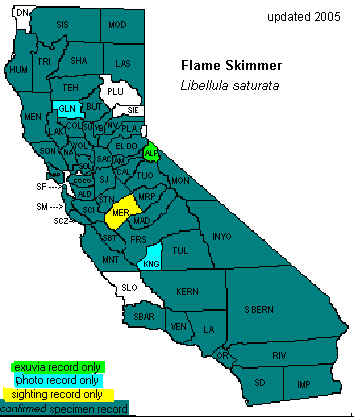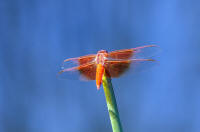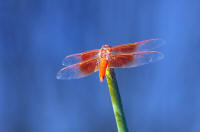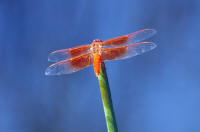|
California Range Map |
Photo |
 |
 |
|
|
|
Taxonomic Hierarchy |
|
Kingdom: |
Animalia -- animal |
|
Phylum: |
Arthropoda -- arthropods |
|
Class: |
hexapoda -- insects |
|
Subclass: |
Pterygota -- iwinged insects |
|
Infraclass: |
Palaeoptera-- wing insects |
|
Superorder: |
Odonatoptera -- ancient winged insects |
|
Order: |
Odonata -- Dragonflies and Damselflies |
|
Suborder: |
Anisoptera -- Dragonflies |
|
Family: |
Libellulidae -- Skimmers |
|
Genus: |
Libellula |
|
Species: |
Libellula saturata |
|
|
Description: |
|
Diet: |
|
Naiad-This
is a fairly large naiad, with a maximum length of 1 1/8
inches (28 mm). The abdomen is rounded, giving it a short,
stocky appearance known as the sprawler form. It is covered
with hairs, but has no hooks or spines as do many other
naiads. |
|
Naiad-Naiads
feed on a wide variety of aquatic insects, such as mosquito
larvae, other aquatic fly larvae, mayfly larvae, and
freshwater shrimp. They will also eat small fish and
tadpoles. |
|
Adult-Male:
red-orange eyes, face,
thorax, legs, abdomen and appendages; thorax unstriped;
wings reddish to slightly beyond nodus, red streak along
leading edge, red veins, area near hind wing base darker;
wings when at rest held out flat, not downward
Adult-Female:
usually paler than
males, wings only show an orange streak along the leading
wing edges and brown streaks near the base; rarer male-like
form exists. |
Adult-The dragonfly
will eat almost any soft-bodied flying insect including
mosquitoes, flies, butterflies, moths, mayflies, and flying
ants or termites. |
|
Size: |
|
|
medium/large, length 50 - 60 mm, wingspan 85 - 93 mm |
|
Range Information: |
|
Habitat: |
|
This
species is found from southwestern Idaho west and south to
southern California, throughout the southwestern U.S., and
east to Wyoming. |
|
This
dragonfly occurs near warm water ponds, warm, slow streams,
and hot springs. In the northern part of its range, it
almost always occurs near hot springs. Specifically in
Idaho, it occurs in low elevation desert in the southwest,
and at hot springs in the central and southeast portions of
the state. |
|
U. S.
Flight
Season: |
|
California Flight Period: |
|
Mid-May
to early September |
|
February - December |
|
Ecology: |
|
Reproduction: |
|
The
naiads live in mud on the bottom of warm ponds, streams, and
springs. They do not actively pursue prey but wait for it to
pass by, a strategy which affords them protection from other
predators. Naiads emerge as adults at night. Adults
generally fly from mid-May to early September. Hunting
occurs from perches on twigs and rocks. This dragonfly is
very common in the southwestern U.S., and around the
Firehole River in Yellowstone National Park because of the
hot springs. |
|
Males
establish and defend territories at prime breeding
locations. After males and females mate, the female flies
singly, without the male attached, to lay her eggs. She does
this by dipping the tip of her abdomen in the shallows of
springs and ponds while hovering just above the water's
surface. |
|
Conservation: |
|
Sources : |
|
G1
G2
G3
G4
G5 |
|



|
|
G5 -
Populations are widespread, abundant, and secure.
|
|
|
|
Global ranks indicate the rarity of a species at a
global scale. Species may be fairly common globally but imperiled
locally. Global ranks have the following meaning:
- G1 - Critically Imperiled - At very high risk of extinction
due to extreme rarity (often 5 or fewer populations), very steep
declines, or other factors.
- G2 - Imperiled - At high risk of extinction due to very
restricted range, very few populations (often 20 or fewer),
steep declines, or other factors.
- G3 - Vulnerable - At moderate risk of extinction due to a
restricted range, relatively few populations (often 80 or
fewer), recent and widespread declines, or other factors.
- G4 - Apparently Secure - Uncommon but not rare; some cause
for long-term concern due to declines or other factors.
- G5 - Secure - Common; widespread and abundant.
- * ? or Q = status unknown or uncertain
|



